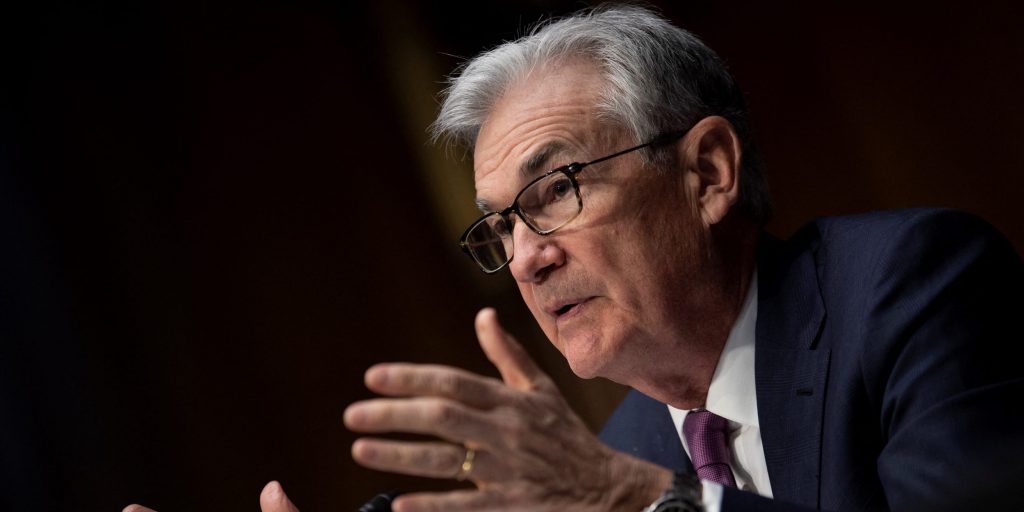- There's "a clock running" to cool inflation before it becomes permanently high, Fed Chair Powell said.
- Inflation expectations remain steady, but an uptick could keep the price surge around much longer.
- Hoping that the supply chain tangle would heal quickly was something the Fed got wrong, Powell said.
Prices in the US are soaring at the fastest pace since 1981, and it's the Federal Reserve's job to slow the rally down.
Making sure inflation doesn't become a permanent part of American life may be an even more difficult task, and it's one Fed Chair Jerome Powell didn't expect he'd face a year ago.
Powell reiterated the importance of keeping inflation expectations at healthy levels with new urgency on Wednesday. While broad inflation accelerated to an 8.6% year-over-year rate in May, Americans still think that the problem should mend itself in the near future. Expected three-years-out inflation has held at about 4% through the past year and currently sits below the highs seen in the fall.
That steadiness is a promising sign for the Fed. Inflation can be a self-fulfilling prophecy. Higher expected inflation can lead businesses to raise prices at a faster pace, as consumers are already bracing for such increases. That can then lead workers to demand bigger raises, which can kickstart a cycle of persistently higher inflation.
With longer-term inflation forecasts still fairly stable, the Fed isn't staring down such a vicious cycle just yet. Yet inflation hasn't started to cool off despite multiple interest rate hikes. That leaves Powell with limited time to slow price growth before expectations break through the ceiling.
"There's a clock running here, where we have high inflation running now for more than a year and it would be bad risk management to just assume that those longer-term inflation expectations will remain anchored," Powell said at a European Central Bank forum on monetary policy.
The central banker's remarks mark a sea change from the outlook he shared just a year ago. Powell previously regarded high inflation as "transitory" in nature. The factors pushing prices higher, he argued, would prove to be temporary and eventually bring inflation back to a sustainable rate. At the June 2021 press conference, the Fed chair cited supply chain bottlenecks and hiring difficulties as some inflation drivers expected to be fleeting.
The last several months have seen the Fed's policymakers adopt a starkly different tone. Officials have refrained from using "transitory" to describe inflation in 2022. Powell said in March that the central bank was no longer assuming that the supply chain would heal through the year, reversing from its prior outlook. The Fed's aggressive rate hikes support the shift, with policymakers in June approving the first 0.75 percentage point increase since 1994.
The Fed has pursued its maximum employment and price stability goals since the 1970s, but doing so today is "a very different exercise than the one that we've had for the last 25 years" when inflation was low, Powell said Wednesday. Uncertainty around what the post-pandemic economy will look like leaves the central bank with little precedent for setting policy, and that's played a significant role in letting inflation reach such dizzying heights, he added.
"What did we get wrong? That really was looking at these supply-side issues and believing they would be solved relatively quickly," Powell said. "It was a very deep-in-the-tail kind of a risk, and those are very hard to predict and assess when they come."
It remains to be seen which inflationary environment becomes the new global norm. Advanced economies struggled with below-target inflation in the decades leading up to the pandemic. Yet the supply chain tangle and Russia's invasion of Ukraine have exposed just how vulnerable the globalized economy has become.
The global economy is now "driven by very different forces" than it was just three years ago, and it's possible that the disinflationary pressures of past decades are gone for good, Powell said. ECB President Christine Lagarde went a step further, saying Wednesday she doesn't think the world will go back to "an environment of low inflation."
The path forward is murky, and it's unclear whether supply chains can heal in the near term. As the Fed moves forward with its plans to cool the price surge, focusing on present-day data will be just as important as studying precedent.
"I think we now understand better how little we understand on inflation," Powell said Wednesday.

